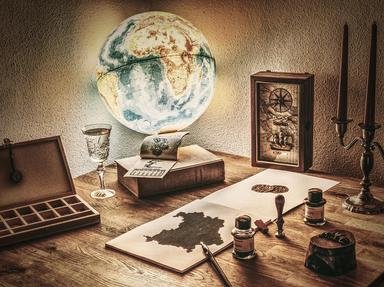Quiz Answer Key and Fun Facts
1. Ralph the Llama lands his parachute on the 48th parallel north in France and suddenly hears a very loud noise, as though ten thousand angry hornets were all zooming in on him. Then he realises that the noise came from a 24-hour long sports car race held nearby. Where in France is Ralph?
2. Ralph crosses the border into Germany in order to take a walk in the Black Forest. He passes through the historic town of Freiburg. What is the English translation of the town's name?
3. Ralph continues his travels into Austria, heading to the birthplace of Mozart. While there, he hears rumors of a garden full of water games. What Salzburg landmark does Ralph trot off to, to view these watery wonders?
4. Ralph reviews some YouTube footage for his next stop in Hungary. The scene is the 1956 Summer Olympics in Melbourne. It is December 6th and in the water polo pool are Hungary and U.S.S.R. The background is the November 1956 Revolution where the Communists crushed a Hungarian uprising with a force of 200,000 troops leaving 5,000 dead and causing nearly 250,000 people to flee. Often referred to as the "Blood in the Water" incident, what statement is NOT true about the game?
5. As Ralph the Llama noshes on a snack of bryndza (a cheese made from sheep's milk), he arrives in Slovakia. Whilst this landlocked country is hugged to the south by Hungary, it is separated from Poland in the north by the Tatra Mountains. What larger mountain range are the Tatra Mountains a part of?
6. Ralph has a love of nature, so he is drawn to see the Primeval Beech Forests of the Carpathians, a natural reserve situated partly in the Ukraine. Which oblast does Ralph visit to view this natural wonder?
7. With the River Danube to the south, a coastline on the Black Sea to the east and the sound of bani clinking in the background, Ralph the Llama can only be in Romania. It is a good thing Ralph noticed these things, as, judging by the national flag, he thought he was somewhere else. Which country's flag is identical to that of the Romanians?
8. After a lunch featuring some excellent local Moldovan wine, Ralph falls asleep on the bus, and wakes up just as the announcement is made that they are crossing the Dniester River. This means they are now in a portion of the former Moldovan Soviet Socialist Republic which declared itself an independent entity in 1992, but which was considered a part of Moldova by the Moldovan government at that time. Which of the following names is NOT applied to this region?
9. Ralph the Llama travels through Russia several times during his trip. During the first section of the journey into Russia, he crosses the longest river in Europe. Which river is it?
10. Next stop for Ralph is a place he is ashamed to say he knows very little about. He reaches the wide open spaces of Kazakhstan, a country which is notable for very many reasons. Which of these is NOT among them?
11. In our trip around the world following the 48th parallel, we travel through only one country that contains a structure that is included in the lists of Wonders of the Medieval World. China actually contains two of these, one being the impressive Great Wall of China, but what is the name of the other structure which is no longer with us?
12. Ralph is intrigued to find that the 48th parallel passes just north of Ulaanbaatar, the capital of Mongolia. Remembering stories he heard of Genghis Khan and the Mongol Empire as a child, he decides to visit this remote spot, which he envisages as a cross between a desert and sweeping steppe country. Imagine his surprise when he finds that Ulaanbaatar is in a valley, at the base of one of Mongolia's sacred mountains (Ralph loves a sacred mountain!). Which of the following is NOT one of the sacred mountains of Mongolia?
13. After passing through China and Mongolia, and whilst still on the Asian mainland, Ralph finds himself in a region known mysteriously as the Jewish Autonomous Oblast. Where is he?
14. A boat ride across the Bering Sea brings Ralph the Llama to the US where he visits the headquarters of the American Miniature Llama Association in a state through which the 48th parallel passes. In what state, known as "The Treasure State" and also "Big Sky Country", is the American Miniature Llama Association?
15. The 48th parallel may seem like an odd choice from the Canadian point of view, although Ralph may not understand why. After all, the dividing line between Canada and most of the US occurs on a different line of latitude. Which close parallel would be significant in regards to the Canadian/US border?
Source: Author
glendathecat
This quiz was reviewed by FunTrivia editor
Pagiedamon before going online.
Any errors found in FunTrivia content are routinely corrected through our feedback system.
